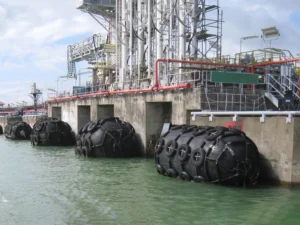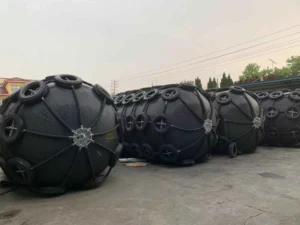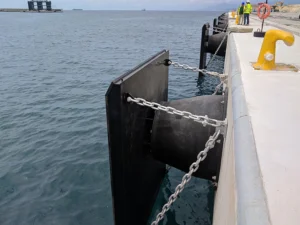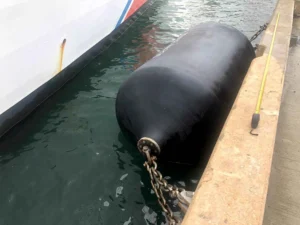As defensas marítimas ajudam barcos, navios e outras embarcações navais a evitar colisões entre si ou contra docas, cais e píeres. Outro nome usado para elas é para-choques marítimos; como os barcos podem bater no porto com força brutal ao estacionar, as defensas marítimas são equipamentos obrigatórios para o transporte naval.
Há vários tipos de defensas marítimas que servem a diferentes propósitos, dependendo da natureza e do tamanho da embarcação. Entretanto, seu principal objetivo é evitar danos ao navio e à superfície.
As defensas de borracha são usadas em ambas as extremidades do navio, incluindo a cabeça e o casco. Da mesma forma, elas estão disponíveis em docas, píeres e estruturas portuárias. Além disso, se você tem um barco e gosta de passear na água, deve considerar a possibilidade de ter defensas de navio para paradas tranquilas.
Neste artigo, apresentaremos diferentes tipos de defensas marítimas.
Então, vamos começar!
Diferentes tipos de defensas marítimas
As defensas marítimas são fornecidas em diferentes tamanhos e finalidades; portanto, se você estiver procurando por uma, aqui estão os principais tipos e seus usos.
Em termos gerais, há três categorias principais de defensas pneumáticas.
- Para-lamas pneumáticos
- Defensas de borracha marítimas
- Para-lamas com enchimento de espuma
-
Defensas pneumáticas

Uma defensa com o formato de um cilindro coberto por pneus e presa à estrutura principal com uma corrente é a defensa pneumática. Geralmente, elas são conectadas por meio de correntes e cordas e flutuam livremente ao lado da doca.
Como são livres, são perfeitas para margens de marés irregulares. Da mesma forma, as defensas pneumáticas são fáceis de instalar, o que as torna a escolha certa para emergências.
Além disso, eles servem para operações STS, em que a transferência de mercadorias ocorre de um navio para outro no meio do mar. Sua livre movimentação os torna o equipamento ideal para esse tipo de operação.
Além disso, eles exigem baixo custo de manutenção e possuem força de reação suave. Em geral, os capitães gostam de instalar pneus e correntes nos para-lamas pneumáticos para proteção extra.
Tipos de defensas pneumáticas
Os para-lamas pneumáticos têm três tipos principais.
-
Para-lamas pneumáticos Yokohama:
Uma das defensas pneumáticas mais antigas e confiáveis, ideal para embarcações de GLP, plataformas oceânicas e grandes docas. Da mesma forma, sua durabilidade faz com que sejam o melhor investimento, pois proporcionam um excelente retorno sobre o investimento.
Além disso, esse tipo de defensa pneumática pode distribuir uniformemente a carga e o estresse. Além disso, uma válvula de segurança oferece uma precaução adicional contra acidentes.
-
Armação de defensas pneumáticas:
É um tipo de para-choque que vem sem uma rede. Eles têm uma cobertura de camada dupla, o que resulta em melhor resistência a danos operacionais. São fáceis de transportar e instalar, o que os torna perfeitos para barcos de pequeno e médio porte.
-
Para-lamas hidropneumáticos:
Uma defensa parcialmente preenchida com água e ar. Elas são usadas em submarinos para garantir que os cascos submersos sejam protegidos adequadamente. Como esses tipos de embarcações exigem soluções na linha d'água, a hidropneumática é ideal. Além disso, eles oferecem serviços exclusivos, como face de contato subsuperficial, deriva variável e baixas pressões no casco.
Características do para-lama pneumático

Os para-lamas pneumáticos têm várias características distintas, incluindo as seguintes.
- O para-lama em cone tem uma faixa de altura de 500 a 9000 mm
- Aumento proporcional de energia e reação
- Baixa pressão no casco
- Facilmente desinflável
- Fácil armazenamento
Aplicativos
- Atracação temporária
- Instalações de petróleo e gás
- Operações de clareamento de navio para navio (STS)
- Para portos com variações extremas de maré
-
Defensas de borracha marítimas
Como o nome sugere, as defensas de borracha são fornecidas principalmente em borrachas. As borrachas são à prova d'água e absorvem o poder de colisão, o que as torna ideais para uma atracação suave.
Considerando sua carga de trabalho pesada, eles são ideais para GNL, terminais offshore, petróleo e berços de contêineres. Como foram projetados para fazer grandes deslocamentos, eles são altamente robustos e duráveis.
Além disso, seu design oferece resistência e robustez.
Outra característica importante dos para-lamas de borracha é que eles podem absorver energia em níveis iguais de diferentes estruturas compactas. Se estiver procurando um para-choque que possa suportar a força total, o para-choque celular é o seu produto.
Tipos de defensas marítimas de borracha
Veja a seguir os diferentes tipos de defensas marítimas de borracha.
-
Defensas de célula:
Como o nome sugere, os para-lamas celulares têm a forma de um cilindro. Elas são uma das melhores defensas da categoria, oferecendo a mais alta taxa de absorção de energia em relação ao peso. Além disso, sua utilidade versátil as torna ideais para embarcações de médio e grande porte.
As defensas celulares podem suportar painéis grandes, oferecem alto desempenho e são ideais para sistemas de baixa pressão no casco.
-
Para-lamas em forma de cone:

As defensas de cone têm formato de cone e oferecem suporte para permanecerem estáveis durante ângulos de impacto pesado de grandes navios. Além disso, seu formato permite que durem mais do que as defensas celulares.
Além disso, a defensa de cone é uma versão aprimorada de uma defensa de célula. O design em cone ajuda esse tipo de defensa a suportar variações de maré em grandes altitudes. Da mesma forma, elas são igualmente úteis para aprimorar as capacidades de manuseio de materiais do guindaste da embarcação. Além disso, as defensas cônicas são famosas por gerenciar embarcações pesadas.
-
Para-lamas do arco:
Esses para-lamas se encaixam perfeitamente em espaços apertados ou limitados, pois seu design e formato permitem que eles se encaixem em locais onde nenhum outro para-lama pode operar. Além disso, eles têm um formato completo com ambos os lados presos à superfície (horizontal ou verticalmente). Da mesma forma, seu design permite amortecer altos níveis de impacto sem sofrer nenhum dano.
Embora as defensas em arco sejam as menores em tamanho, elas podem gerenciar cargas de trabalho pesadas e são incrivelmente confiáveis. Além disso, elas são altamente personalizáveis e oferecem excelente proteção à embarcação durante as condições de atracação.
-
Para-lamas cilíndricos de borracha:
Esses foram os primeiros para-lamas produzidos e se desenvolveram ao longo do tempo até chegarem ao seu formato e uso atuais. Eles oferecem instalação simples e excelente absorção de força.
Além disso, eles têm tamanhos diferentes e suportam atracação mais suave.
-
D Para-lamas:
As defensas D são econômicas e duráveis. Seu formato faz com que sejam perfeitas para cais e embarcadouros menores. Além disso, os marinheiros podem utilizá-las em rebocadores, embarcações de pesca e pequenos barcos.
Características das defensas marítimas de borracha
Os para-lamas de borracha têm as seguintes características distintivas.
- O para-lama celular tem uma faixa de altura de 400 e 3000 mm
- Fácil de montar e instalar
- Excelente resistência à força bruta
- Robusto
- Custo-benefício
Aplicabilidade
Os para-lamas celulares são perfeitos para as seguintes finalidades.
- Terminais a granel
- Recipientes de tamanho grande
- Terminais de petróleo e gás
- Terminais de cruzeiros
- Marinha
- Terminais de balsas e RoRo
-
Para-lamas com enchimento de espuma

Os para-lamas de espuma são fornecidos em uma estrutura de duas ou quatro camadas. O núcleo interno é de polietileno e o revestimento é de elastômero de poliuretano reforçado. A penetração de água nessas partes é nula.
Da mesma forma, eles são duráveis e facilmente reparáveis.
Tipos de defensas preenchidas com espuma
Os para-lamas de espuma são dos seguintes tipos.
- Defensor de espuma portátil
- Defensas de proteção contra o mar
- Para-lamas de rosca
- Para-lamas compostos
- Defensas do rebocador
Características das defensas de espuma
Os para-lamas preenchidos com espuma têm as seguintes características principais.
- Alta absorção de energia/baixa força de reação
- Inafundável
- Baixos custos de manutenção
- Fácil instalação
- Custo-benefício
Aplicabilidade
Os para-lamas com enchimento de espuma são ideais para as seguintes finalidades.
- Operações STS
- Condições tempestuosas
- Marinha
Guia de compra de defensas marítimas
A compra de defensas marítimas é uma tarefa difícil, pois há muitos tipos diferentes. Entretanto, alguns pontos de consideração permanecem válidos e devem ser verificados antes da compra de qualquer defensa marítima.
- Procure um para-choque que tenha material de alta qualidade para um excelente desempenho
- Um Fender que exige um custo mínimo de manutenção é sempre uma opção melhor
- Determine suas necessidades e compre aquele que satisfaça suas demandas
- Opte por uma defensa marítima que possa resistir a todos os tipos de condições climáticas, inclusive as mais severas
- O tipo de defensa marítima que é durável, mesmo que custe um pouco mais caro, é uma opção melhor do que uma mais barata.
Escolha o para-lama certo na JerryBorg Marine!
Os usuários precisam de esclarecimentos ao escolher o para-lama certo que vale a pena gastar. Mas, geralmente, eles acabam comprando o tamanho errado do para-lama marítimo.
Como existem muitos tipos de defensas marítimas, escolher a que melhor se adapta ao seu barco é uma decisão crítica. Para torná-la descomplicada, JerryBorg Marine é a melhor opção para o fabricante de defensas marítimas.
Portanto, se você estiver procurando um para-lama durável, resistente e versátil, a Jerryborg Marine está à sua disposição. Aqui, você pode obter o tamanho e o tipo certos de Defensas marítimas de borracha adequado para qualquer condição climática.
Aqui está um guia simples para escolher o para-lama de barco do tamanho certo.
- Comprimento do barco inferior a 10 pés - Diâmetro do para-lama de 3 polegadas - Pequeno
- Comprimento do barco de 10 a 15 pés - diâmetro do para-lama de 3 a 4 polegadas - Pequeno
- Comprimento do barco de 20 a 25 pés - diâmetro do para-lama de 6 a 6,5 polegadas - Médio
- Comprimento do barco de 25 a 35 pés - diâmetro do para-lama de 8 a 8,5 polegadas - Médio
- Comprimento do barco de 35 a 50 pés - diâmetro do para-lama de 10,5 a 12 polegadas - Grande
- Comprimento do barco de 60 a 72 pés - diâmetro do para-lama de 15 a 24 polegadas - Grande
Pensamentos de despedida
As defensas marítimas são uma necessidade quando se trata de transporte marítimo. Elas ajudam embarcações de todos os tamanhos a parar na costa ou até mesmo a deslocar equipamentos durante operações STS (ship-to-ship). Há diferentes tipos de defensas para navios, dependendo de seu uso e do material de produção.
Os tipos mais conhecidos de defensas marítimas incluem defensas de borracha, defensas pneumáticas, defensas de borracha, defensas de cone e defensas de célula. Além disso, o sistema de defensas de navegação é uma das partes mais importantes do sistema de navegação.
Portanto, se estiver procurando por uma defensa que seja durável, resistente e que possa funcionar em qualquer condição ambiental, a Jerryborg Marine está à sua disposição. Você pode obter o tamanho e o tipo certos de defensa no conforto de sua casa.
Na Jerryborg Marine, garantimos que você obtenha o para-lama certo para o seu barco. Portanto, deixe-nos absorver toda a força do barco enquanto você aproveita seu passeio.
